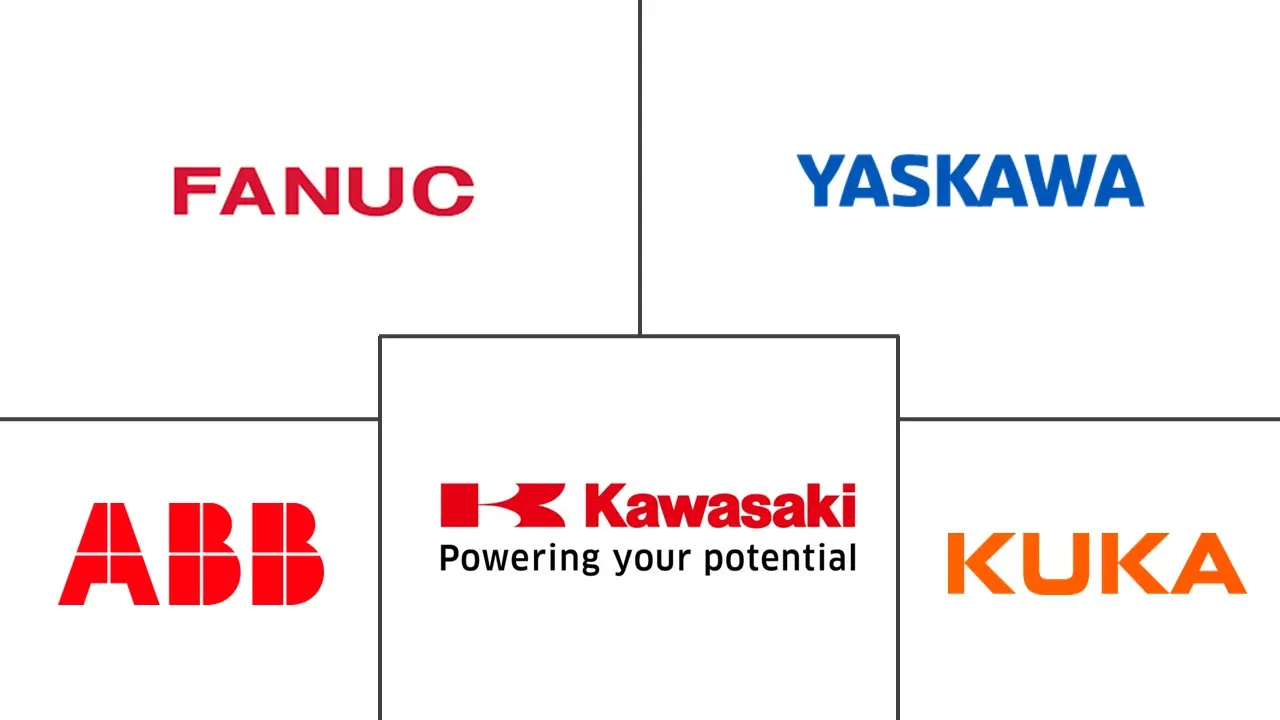Asia-Pacific Industrial Robots Market Size and Share
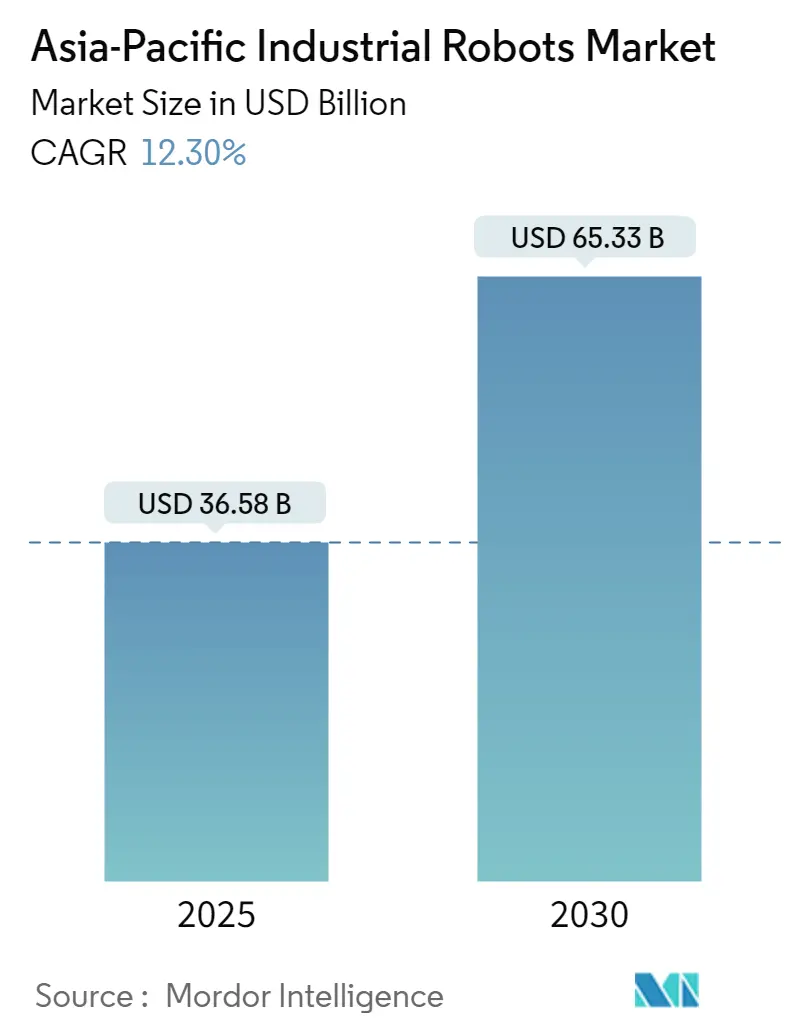
Asia-Pacific Industrial Robots Market Analysis by Mordor Intelligence
The Asia-Pacific Industrial Robots Market size is estimated at USD 36.58 billion in 2025, and is expected to reach USD 65.33 billion by 2030, at a CAGR of 12.3% during the forecast period (2025-2030).
The applications of robotics are growing at a breathtaking speed. Industrial robotic arms could be used for a wide range of applications based on the multitude of sensors and vision systems capable of viewing images to aid with their computer-based control.
- Most of the industrial sectors are witnessing trends, i.e., the rising demand for high-quality products (which need proper end-to-end visibility in the manufacturing process), the need for energy conservation, and the rising focus on workplace safety. Incremental advancements in technology, coupled with the sustained increase in the development of manufacturing facilities, are also expected to drive this market.
- Trends, such as rising penetration of the IoT and investments in robotics across multiple regions, are expected to drive the demand for industrial robots in the market. Industry 4.0, the newest industrial revolution, fuelled the development of new technologies, like collaborative robots and AI-enabled robots, etc., that enabled industries to use robots to streamline many processes, increase efficiency, and eliminate errors. Increased workplace safety and improved production capabilities further drive industries to invest in robotic systems.
- Industrial robot adoption is evident across the automotive space and extends to the consumer goods market, owing to the demand for industrial robots and the business goals of the market players. According to a survey conducted by Veo Robotics Inc., 57% of global manufacturers believe that instead of replacing human workers, they should work alongside humans to supplement their work in their facilities. Such instances in the market are expected to promote the demand and applications of industrial robots.
- This trend was dominated by positive market developments and the growing adoption of industrial robots in the electrical/electronics industry.
- The growing demand and production of solar panels, electrical machinery, semiconductors, household appliances, computers, video and electronic entertainment goods, and telecommunication devices have also been pushing manufacturers to adopt industrial robots for effective and cost-effective productions at a larger scale. Various companies have been undertaking various initiatives in the market, intending to strengthen their presence in the market.
Asia-Pacific Industrial Robots Market Trends and Insights
Adoption of Industrial Robots in Automotive Industry Is Expected to Fuel The Market
- Over the few decades, the automotive industry has been using robots as a part of their assembly lines for various manufacturing processes. With the advancing technologies, the applications and adoption of industrial robots have increased over time.
- Some of the applications of industrial robots in the automotive industry include robot vision, assembly, spot and arc welding, painting, sealing, and coating, part transfer, internal logistics, materials removal, polishing robots, machine tending, and quality inspection.
- Robots are more accurate, efficient, dependable, and flexible for production lines. Applications of industrial robots in the automotive industry enable it to remain one of the largest users of robots and one of the most automated supply chains globally. With thousands of parts and wires in every vehicle, it takes a complex manufacturing process to get the components to where they should be added.
- Robots also significantly produced fuel systems, engines, electronics, lights, mirrors, vehicle body parts, and more. Automobile robots are becoming quicker, smarter, and more productive, which has the advantages of lowering labor costs, achieving new throughput targets, and raising quality.
- Internal logistics applications for industrial robots are widely used in the automotive industry. In a manufacturing environment, raw materials and other components can be moved from storage locations to the factory floor using autonomous mobile robots (AMRs) and other automated vehicles, such as forklifts.
- Further, one of the largest robotic application users is the automotive sector's manufacturing and assembly of parts. Assembly lines have become more productive since a decade ago, thanks to advances in the accessibility of programming and deploying robot workforces. Because of this technology, the automotive sector continues to have one of the most automated supply chains and one of the highest robot usage rates in the world. The growing demand for automotive in the market is expected to further increase the need for industrial robots in the automotive industry.
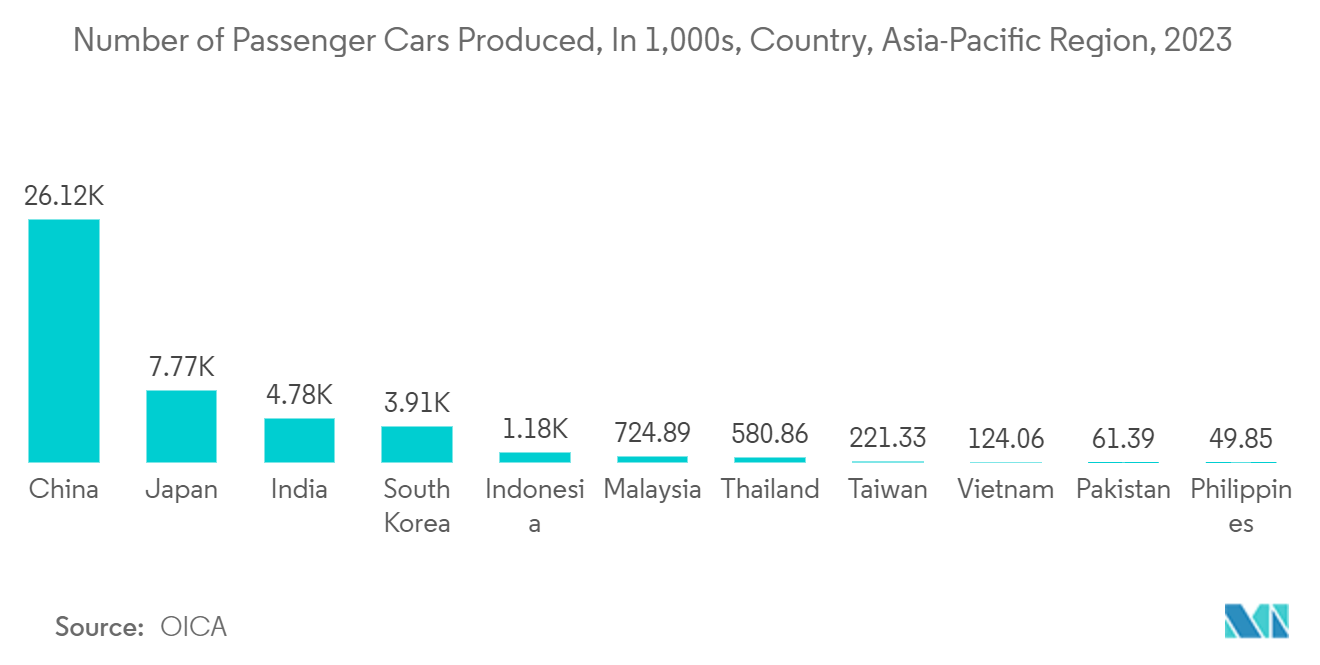
Industrial Robots In India Is Expected To Grow At A Rapid Rate
- Indian industry is rapidly moving towards automation for growing production volume, accuracy, and safety. To build up industrial automation for increasing the product supply and domestic manufacturing.
- Due to the modernization and digitalization of production areas to combat the pandemic, the country aimed to expand its range of industrial robots from conventional payload handling robots to new collaborative robots to integrate completely into workplaces in the next few years.
- India's manufacturing sector is embracing automation and new-age technologies to integrate with Industry 4.0. In the region, numerous manufacturers are shifting focus toward robotic automation to enhance productivity and output quality. This will enable workers to concentrate on higher-skilled tasks while preventing injuries during production.
- Moreover, many companies are shifting production units from China to other nations, such as India, owing to lower labor costs and infrastructure improvements. Such trends are also expected to contribute towards the growth of Industrial Robots in the market in the country.
- Moreover, as per the International Federation of Robotics (IFR), sales of industrial robots in India reached a new record of 4,945 units installed. This is an increase of 54 percent compared to the previous year (2020: 3,215 units). In terms of annual installations, India now ranks in tenth position worldwide.
- In May 2023, as per the International Federation of Robotics (IFR), the Indian government supports growth in the industrial sector as a vital figure affecting the Gross Domestic Product (GDP). The countrys GDP of about USD 3 trillion ranks fifth, head-to-head with the UK and France - behind Germany, Japan, China, and the USA. Such trends are expected to further drive the Industrial Robots market in the region.
- Further, the growing urbanization rate and changing lifestyle of the population across various countries is among the major factor driving the demand for household robots in the region. For instance, according to the Population Reference Bureau, the urban populations of both China and India are anticipated to grow by more than 340 million by 2030. Even a small country such as Laos is anticipated to add about 3.2 million to its urban population while it moves to only 43% urbanized in 2030.
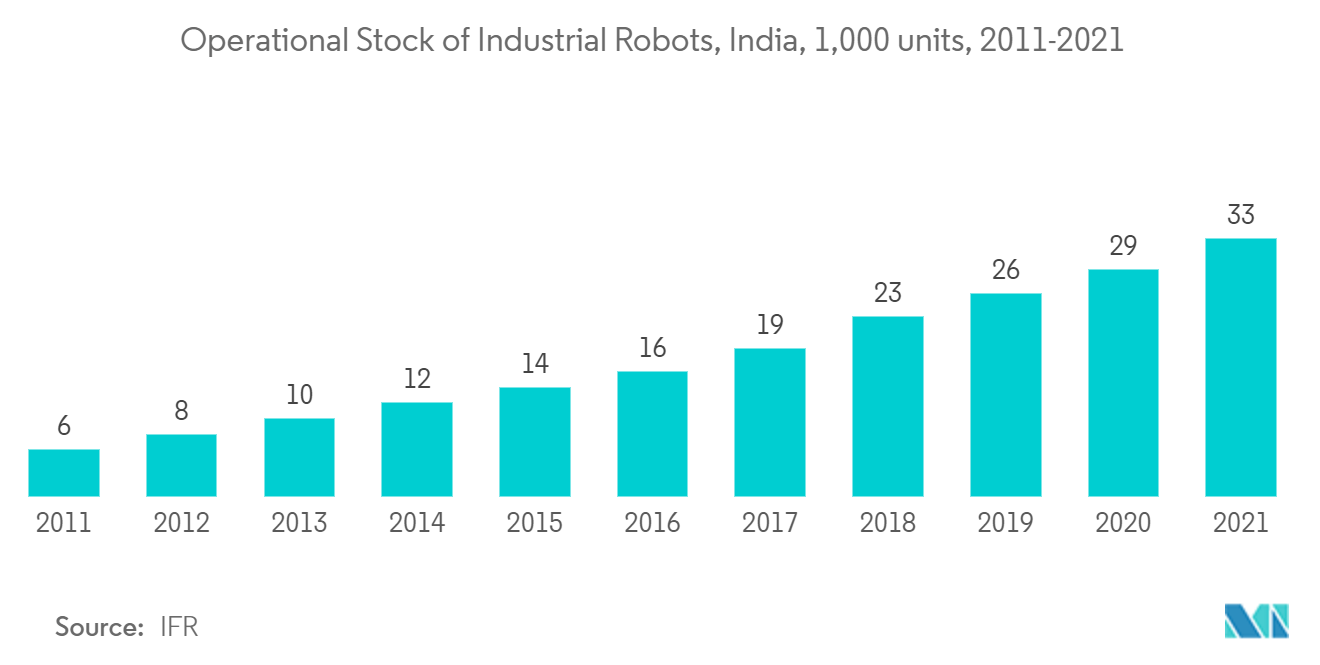
Competitive Landscape
The Asia-Pacific Industrial Robots Market is semi-consolidated, with significant players like FANUC, Yaskawa, KUKA, and ABB. Players in the market are adopting strategies such as partnerships, mergers, Collaborations, innovations, and acquisitions to enhance their product offerings and gain sustainable competitive advantage.
In April 2022, ABB added two new robot families to its portfolio to automate shopfloors of electric vehicle manufacturers. ABB's robots have been deployed as a part of the Ola mega factory in Bengaluru, India, which has deployed sustainable robotics solutions like pixel paint technology optimizing paint applications to enhance productivity and reduce emissions.
Asia-Pacific Industrial Robots Industry Leaders
KUKA
ABB
FANUC
Yaskawa
Kawasaki
- *Disclaimer: Major Players sorted in no particular order
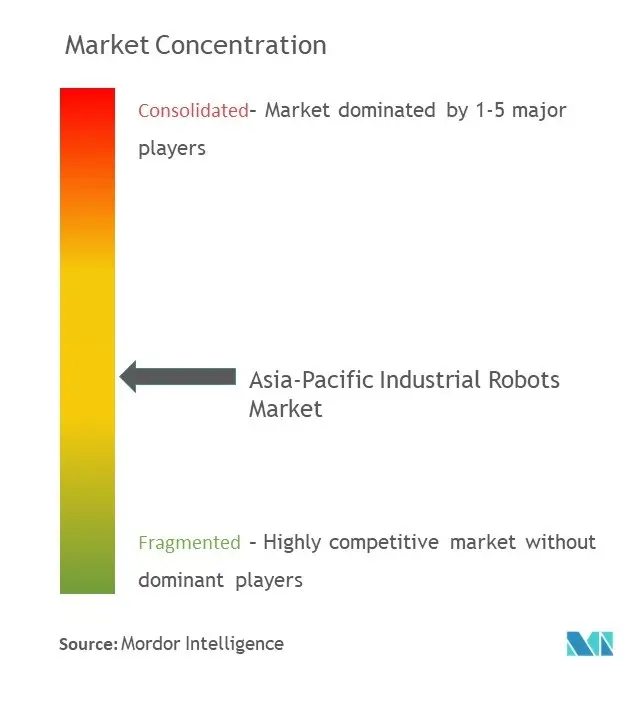
Recent Industry Developments
- May 2023 - the Telangana government of India introduced a new policy known as the State Robotics Framework. It is designed to establish a self-sustaining robotics ecosystem and to position the state as a leader in robotics in India. The policy would aim to provide support for research and development, encourage collaboration between academia and industry, and promote the adoption of robotics technology across various sectors. Further, Telangana plans to establish a Robo Park with testing facilities, co-working spaces, and co-production or manufacturing options as part of the State Robotics Framework. These facilities would be set up either on state-owned sites or in collaboration with industry, academia, and incubators at competitive rates. Furthermore, the state intends to establish a world-class robotics accelerator to provide startups with the necessary support, including incubation, authorization, infrastructure, investor connections, market insights, and mentorship.
- April 2023 - Doosan Robotics, a global manufacturer of collaborative robots, launched its E-SERIES, the company's NSF-certified collaborative robot line specifically created for the food and beverage (F&B) industry. With the launch of E-SERIES, Doosan Robotics has revealed 13 new cobots, the biggest lineup in the worldwide cobot market, including the M, A and H-SERIES, customized for process performance and industrial needs for customers. Such initiatives by the companies in the market is expected to further promote the growth of Industrial Robots in the Asia-Pacific Market during the forecast period.
- In December 2022, ABB officially opened its state-of-the-art, fully automated and flexible robotics factory in Kangqiao, Shanghai, China. The 67,000 meter square production and research facility represents a USD 150 million investment by ABB and would deploy the company's digital and automation technologies to manufacture next generation robots, with an aim to enhance ABB's robotics and automation leadership in China.
Asia-Pacific Industrial Robots Market Report Scope
An industrial robot is a robotic system used for manufacturing. Industrial robots are automated, programmable, and capable of movement on three or more axis. The typical applications of robots include welding, painting, assembly, picking, and placing for packing and labeling, palletizing, product inspection, and testing, all accomplished with high endurance, speed, and precision.
The Asia-Pacific industrial robots market is segmented by product category (articulated, SCARA, cartesian/linear/gantry, parallel/delta, other product categories (cylindrical and spherical)), by end user vertical (automotive, electronics/electrical, plastic and chemical, metal & machinery, food, beverages, and tobacco, other manufacturing verticals, and other non-manufacturing verticals), and by country (China, India, Korea, Australia & New Zealand, Japan, Indonesia, Malaysia, Singapore, Thailand, Vietnam, and Rest of Asia-Pacific). The market sizes and forecasts are provided in terms of value in USD for all the above segments.
| Articulated |
| SCARA |
| Cartesian/Linear/Gantry |
| Parallel/Delta |
| Other Product Categories (Cylindrical and Spherical) |
| Automotive |
| Electronics/Electrical |
| Plastic and Chemical |
| Metal & Machinery |
| Food, Beverages, and Tobacco |
| Other Manufacturing Verticals |
| Other Non-Manufacturing Verticals |
| China |
| India |
| Korea |
| Australia and New Zealand |
| Japan |
| Indonesia |
| Malaysia |
| Singapore |
| Thailand |
| Vietnam |
| Fanuc Corporation |
| Yaskawa Electric Corporation |
| KUKA AG |
| ABB Ltd |
| Kawasaki Heavy Industries, Ltd. |
| Seiko Epson Corporation |
| Staubli International AG |
| Nachi-Fujikoshi Corporation |
| Comau S.p.A. |
| By Product Category | Articulated |
| SCARA | |
| Cartesian/Linear/Gantry | |
| Parallel/Delta | |
| Other Product Categories (Cylindrical and Spherical) | |
| By End-user Vertical | Automotive |
| Electronics/Electrical | |
| Plastic and Chemical | |
| Metal & Machinery | |
| Food, Beverages, and Tobacco | |
| Other Manufacturing Verticals | |
| Other Non-Manufacturing Verticals | |
| By Country | China |
| India | |
| Korea | |
| Australia and New Zealand | |
| Japan | |
| Indonesia | |
| Malaysia | |
| Singapore | |
| Thailand | |
| Vietnam | |
| COMPETITIVE LANDSCAPE | Fanuc Corporation |
| Yaskawa Electric Corporation | |
| KUKA AG | |
| ABB Ltd | |
| Kawasaki Heavy Industries, Ltd. | |
| Seiko Epson Corporation | |
| Staubli International AG | |
| Nachi-Fujikoshi Corporation | |
| Comau S.p.A. |
Key Questions Answered in the Report
How big is the Asia-Pacific Industrial Robots Market?
The Asia-Pacific Industrial Robots Market size is expected to reach USD 36.58 billion in 2025 and grow at a CAGR of 12.30% to reach USD 65.33 billion by 2030.
What is the current Asia-Pacific Industrial Robots Market size?
In 2025, the Asia-Pacific Industrial Robots Market size is expected to reach USD 36.58 billion.
Who are the key players in Asia-Pacific Industrial Robots Market?
KUKA, ABB, FANUC, Yaskawa and Kawasaki are the major companies operating in the Asia-Pacific Industrial Robots Market.
What years does this Asia-Pacific Industrial Robots Market cover, and what was the market size in 2024?
In 2024, the Asia-Pacific Industrial Robots Market size was estimated at USD 32.08 billion. The report covers the Asia-Pacific Industrial Robots Market historical market size for years: 2022, 2023 and 2024. The report also forecasts the Asia-Pacific Industrial Robots Market size for years: 2025, 2026, 2027, 2028, 2029 and 2030.
Page last updated on:
Asia-Pacific Industrial Robots Market Report
Statistics for the 2025 Asia-Pacific Industrial Robots market share, size and revenue growth rate, created by Mordor Intelligence™ Industry Reports. Asia-Pacific Industrial Robots analysis includes a market forecast outlook for 2025 to 2030 and historical overview. Get a sample of this industry analysis as a free report PDF download.
